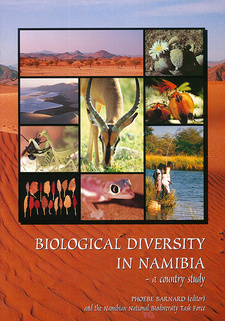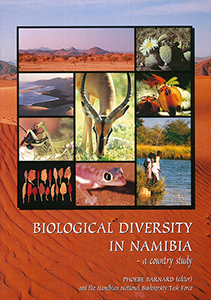Biological diversity in Namibia. A country study, by Phoebe Barnard

Biological diversity in Namibia. A country study, by Phoebe Barnard. Namibian National Biodiversity Task Force. Windhoek, Namibia. ISBN 0869764365 / ISBN 0-86976-436-5
The importance of biological diversity, or biodiversity, to Namibians of today and tomorrow cannot be overemphasised, says Dr. Phoebe Barnard.
For millennia, people have relied on ecosystems to meet their basic needs for food, water and other natural resources. Preserving these natural systems is thus so vital for our national development, our livelihoods, and indeed our very survival, that severe environmental degradation would be calamitous. So too would it be if we do not strike the right balance between our demands on the natural environment and the productive potential of this environment. Essentially, this means safeguarding our biological diversity, that is, the entire, complex, fascinating variety of the living world and its ecological 'life support systems.' Namibia has, by ratifying the Convention on Biological Diversity and related environmental treaties such as the Ramsar Convention on Wetlands and the Convention on International Trade in Endangered Species (CITES), joined the international community of nations in acknowledging the need for urgent action to conserve species and ecosystems and prevent, as far as possible, the loss of biodiversity during human development. In Namibia we have a fairly long history of information to support this process. Since the eighteenth century, early explorers and subsequent colonial administrators in Namibia have fostered scientific enquiry, including biological research. The problem lay in that such enquiry was often unfocused, uncoordinated, and lacked clear priorities. This book, Biological diversity in Namibia: A country study by Phoebe Barnard, and the publications for lay readers which will follow, represents something of a milestone in Namibia's history of biodiversity knowledge and management. For one, it is an important snapshot of what we know and where we are in terms of biological diversity as we turn the corner of the next millennium. Second, it is a significant achievement in terms of bringing together previously fragmented, uncomputerised, inaccessible and poorly-understood information held by numerous biologists, ecologists, and biosystematists. Thirdly, it sets these data in a socioeconomic perspective by incorporating important analyses of the economic values of biological diversity, biological resources, and ecosystem functions which are so crucial to Namibia, as well as the legal framework under which these values can be protected and realised. And finally, it sets out some important priorities for the next century. With these priorities, we can fill gaps in our knowledge and understanding, synthesise material to support human development and the environmental planning process, and select and train the cream of Namibia's upcoming scientists, economists and development workers to carry this process forward into the foreseeable future.
This is an excerpt from Biological diversity in Namibia. A country study, by Phoebe Barnard.
Title: Biological diversity in Namibia
Subtitle: A country study
Editor: Phoebe Barnard
Namibian National Biodiversity Task Force
Windhoek, Namibia
ISBN 0869764365 / ISBN 0-86976-436-5
Softcover, 21 x 30 cm, 325 pages, numerous colour photos, diagrammes and tables
Barnard, Phoebe im Namibiana-Buchangebot
Biological diversity in Namibia. A country study
An attractive environmental country study with countless photos about the biological diversity in Namibia.

